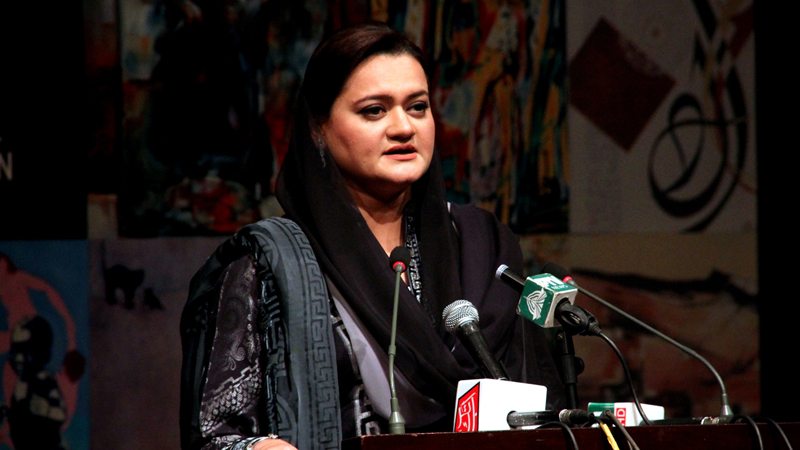 As many as 556 paintings and 140 sculptures and installations by 384 artists from all over the country were put on display to attract a huge number of art lovers and promote arts and culture through this national platform (SHOULDER)
As many as 556 paintings and 140 sculptures and installations by 384 artists from all over the country were put on display to attract a huge number of art lovers and promote arts and culture through this national platform (SHOULDER)
Islamabad – The Minister of State for Information, Broadcasting and National Heritage Marriyam Aurangzeb inaugurated the Ninth National Art Exhibition at the Pakistan National Council of the Arts (PNCA) on Tuesday.
The ninth grand art show is dedicated to the nine legendary artists of Pakistan including Ahmed Khan, Bashir Ahmad, Colin David (Late), Hajra Mansur, Ijaz ul Hassan, Mansur Rahi, Iqbal Geofrey, Saeed Akhtar and Zulqarnain Haider.
As many as 556 paintings and 140 sculptures and installations by 384 artists from all over the country were put on display that attracted a huge number of art lovers. These works were selected from the regional exhibitions that PNCA organised during the last several months. The themes of the regional exhibitions were quite different this time, namely from Mehergarh to Quetta, from Harappa to Lahore via Katas, from Akra to Peshawar via Takht Bai, from Mohenj-o-Daro to Karachi via Makli and from Takhtbai to Islamabad.
All the exhibits though reflect creativity and versatility, they also show a reflection of regional cultural signatures. Every school of thought and style of painting is well represented in the exhibition. From impressionist style to surrealist landscapes, miniatures to calligraphic paintings, abstract art to drawings in charcoal, video Installations to 3D art in the form of relief and sculptures in almost all mediums and styles.
‘Situation 101’, a contemporary creative installation by Jamal Shah, remained centre of attraction with 101 sculptures in a very oddly humble situation and with a 25 feet high cage. The installation is a bold reflection of the entire nation being fooled by the influentials.
Speaking on the occasion, the Minister of State for Information, Broadcasting and National Heritage Marriyam Aurangzeb said the government was to restore peace in the country so that the citizens could expand their professional work. The government has taken all possible measures to provide opportunity to the artists to explore their creativity. Some interventions are in the process, this would boost the performing and visual arts in the days to come.
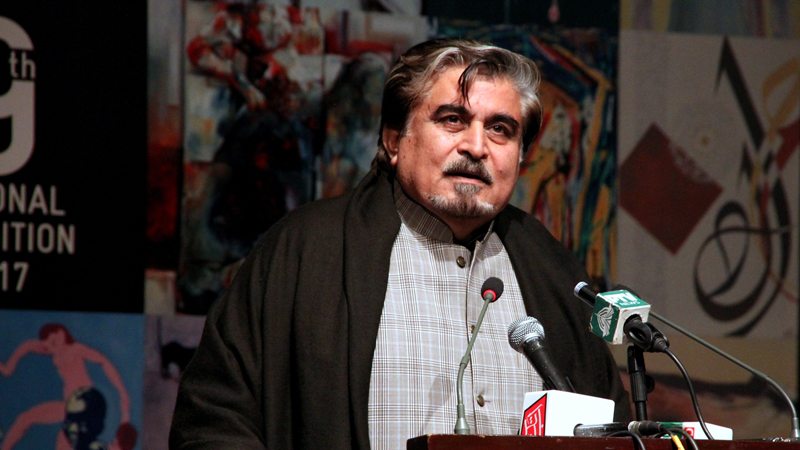 Jamal Shah, PNCA Director General said the Ninth National Exhibition coincides with the 70th Independence Day celebrations and is being revived after a gap of 13 years as a regular annual event. Prior to the big event, PNCA organized a series of regional exhibitions representing all provinces which were given relevant context according to the cultural heritage of the land.
Jamal Shah, PNCA Director General said the Ninth National Exhibition coincides with the 70th Independence Day celebrations and is being revived after a gap of 13 years as a regular annual event. Prior to the big event, PNCA organized a series of regional exhibitions representing all provinces which were given relevant context according to the cultural heritage of the land.
Contemporary art from Pakistan has lately witnessed a few very significant international breakthroughs that has put Pakistani art in a respectable and sought-after slot internationally. The art institutions in this regard have played an integral part in grooming new talent, equipped with intimate knowledge and tools (both traditional and contemporary), producing works of high calibre alongside their established counterparts
He said, the reoccurring theme of culture connects the work of artists from different regions, as it becomes a point of intersection for people itself. The exhibitions represented the land, life, people and the cultural diversity of Pakistan which culminated into a National Exhibition as the work for such was selected by competent committees from all regional exhibitions. The exhibition includes works of almost 500 artists from all over Pakistan in the first National Exhibition being held in the new building. Artists have used a broad spectrum of formats and techniques including painting, sculpture, calligraphy, photography, miniature installations and videos.
Region Artists Paintings
Federal 111 140
Sindh 110 150
Punjab 114 140
Baluchistan 22 40
Khyber Pakhtunkhwa 27 49
Total 384 519
Sculptures, 3D & — 140
Installations
In the 70th year of Pakistan’s Independence, the nation took a critical look at the increasing enthusiasm for heritage, tradition and evolving contemporary practices. Over the years, the art scene in Pakistan has evolved within and beyond the traditional ways of practice of art making and looking at art. Attentive to the way geopolitical engagements and changes impact the relationship with history, artists explored the current perception of tradition. The contemporary art scene over the last three decades have changed dramatically because the artists have remained alert to the rapidly changing socio political landscape. Hence contemporary expression appears to be informed by authentic socio-political dialogue and contemporary aesthetic challenges.
Contemporary art from Pakistan has lately witnessed a few very significant international breakthroughs that has put Pakistani art in a respectable and sought-after slot internationally. The art institutions in this regard have played an integral part in grooming new talent, equipped with intimate knowledge and tools (both traditional and contemporary), producing works of high calibre alongside their established counterparts and continuously making the realm of art more exciting.
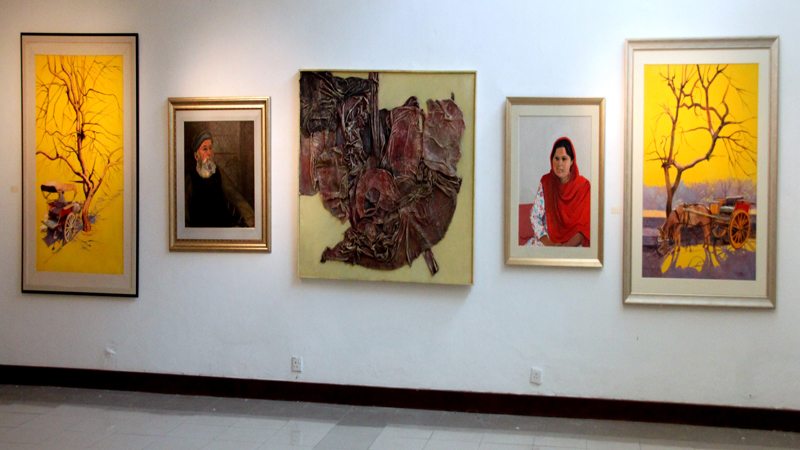 To sum it up, the exhibition displays a highly diversified range of experimentation both in two-dimensional work and other works including sculpture, installations and videos. It is hoped that the work will generate dialogue, discussion and creative discourse, as the purpose of this exhibition is to stimulate the artist’s mind, open new horizons and promote arts and culture through this national platform.
To sum it up, the exhibition displays a highly diversified range of experimentation both in two-dimensional work and other works including sculpture, installations and videos. It is hoped that the work will generate dialogue, discussion and creative discourse, as the purpose of this exhibition is to stimulate the artist’s mind, open new horizons and promote arts and culture through this national platform.
The profiles of the nine art icons the Ninth National Art Exhibition is dedicated to, is as follows:
* Bashir Ahmad
Bashir Ahmad is a miniature maestro and a living legend. He founded the Mughal Miniature Painting Bachelor’s Degree Program at the National College of Arts. Earlier, there was no institution in the world to offer a professional degree in this discipline. Ahmad designed the first ever curriculum of miniature painting and started the department in 1982. He served as a former principal, Head of Department of Fine Arts and also headed the Miniature Painting Department at National College of Art, Lahore.
Ahmad began as an apprentice to the late Sheikh Shujaullah in 1972, the last of Mughal court painters and took the responsibility of the revival, preservation and continuation of Mughal, Persian and Contemporary Miniature Painting art after his mentors passed away.
Ahmad completed his Masters in Fine Arts and Masters in Public Administration from Punjab University in 1984 and 2004 respectively. In 1974, he was awarded the National Diploma of Arts by the National College of Arts. Apart from that his work has also been exhibited at the national and international level. Ahmad conducted lectures and held workshops at various institutions including Oklahoma State University, University of Central Arkansas, Kansas City Art Institute, Irvine University, Orange County, Triston L.A and Harvard University. His work is revered and owned by private collectors all over Asia, Europe and America.
Today, the art of Mughal Miniature Painting owes its survival and recognition to Bashir Ahmed for his continued support and services.
* Mansoor Rahi
Mansoor Rahi is considered a cubist legend of Asia. He was born in Maldah, West Bengal, in 1939. In 1962 he graduated in Fine Arts from the Government College of Arts and Crafts. Rahi is a recipient of the President’s Award for Pride of Performance.
Rahi is the only painter in the school of cubism who was given a new track, an offshoot of cubism i.e. Cubo-Rayonism, the style involves Rayonistic activity in the display of high value of cubistic form. His paintings and drawings depict abstraction yet the visual imagery remains representational, which marks another difference between his early work in Karachi and his later work in Islamabad. Such dissimilarities are amalgamated through an essence of Cubism that runs through his entire body of work, creating interplay of opposites.
The government has taken all possible measures to provide opportunity to the artists to explore their creativity. Some interventions are in the process, this would boost the performing and visual arts in the days to come
Rahi’s paintings not only create a mood of innovating new forms and illusion of values but also open a vision of free expression with spontaneous use of brush strokes. His present day work titled ‘Resurrect Rock Series’ in colour as black and white starts in USA. It makes a change of vision by entering into classical realism from the non-evocative abstraction.
One of the major contributions of Rahi is conducting an educational program on National television for six years. Over the years, his work spread to a major art institution which has produced many well-known artists, and he exhibited extensively both nationally and internationally.
* Hajra Mansoor
Hajra Mansoor completed her education in Fine Arts from Lucknow Art College and moved to Karachi with her sister Rabia Zuberi. Together, they opened the first art school in Karachi named ‘Karachi School of Arts’. Hajra established this school and researched in creative synthesis of painting, entering in the evolution of periodical phases in her life time work. She has proved her mantle in different styles: Academic Realism, Classism, Oriental Intuitionism, Oriental Formalism and Neo Romanticism.
Hajra is one of the most sought after artists in Pakistan and her style is inspired by tradition combined together with modern artistic sensibilities. Her themes are linked to the romance of an older age inspired by traditional schools of Mughal Miniature art. She has created a unique genre by introducing experimental nuances into her work with contemporary media techniques, rhythmic flow of brush strokes and decorative elements rendered in a transparent luminosity, holding a universal appeal.
Hajra has held exhibitions in Bangladesh, India, China, Japan, Turkey, Iran, France, England, Germany, Hong Kong, Tokyo, Mumbai and America. She was the recipient of the National Chughtai Award in 1989. She also received prestigious President’s Pride of Performance with the title of Safeer-e-Mashriq in the year 2009.
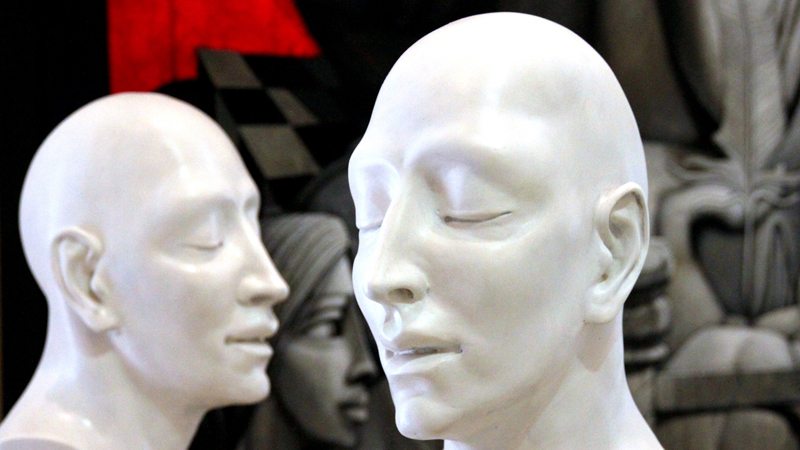 * Ijaz ul Hassan
* Ijaz ul Hassan
Ijaz ul Hassan studied painting at the Punjab University and St. Martins School of Art, London. He received his Master’s Degrees in English literature from Government College Lahore, Punjab University and Cambridge University (UK). Hassan is one of the most seasoned and recognized Pakistani artists. His work established a new trend in Pakistani painting in the late 60s. During this period, he employed popular images clipped from print media, posters and cinema hoardings. Later, these were used to express larger social concerns.
During Zia’s martial rule, Hassan employed symbols to have his ideas known to the viewer. He rendered a series of paintings based on a vine girdling a tree, hoping for spring. He also sought trees that had matured and acquired striking individual identities expressing irrepressible resolve not to give in. Most of these and other images symbolize human struggle and growth. He also records the eternal flux of nature where things inevitably perish but are soon reborn in richer splendour.
Ijaz ul Hassan is one of the few mural painters of Pakistan. He is a critic and author of Painting in Pakistan, published in 1990 by Ferozsons, Lahore. He is a recipient of the President’s Award for Pride of Performance and Sitara-e-Imtiaz.
* Iqbal Geoffrey
Paris Biennial (1965) laureate Syed Iqbal Geoffrey has lived in Europe and the Americas since 1960. Over 260 one-man shows of his work have been held on both sides of the Suez. Besides being the youngest artist in the national collections of the United Kingdom, his thought provoking artworks have been included in the major 20th century art. He is a pioneer and a leading light of post conceptual art process systems. His admirers included John G. Poewers , Susan Sontag, Albert A. List, Perry T. Rathbone, Elizabeth R. Bayne, Sir Phillip Hendy, Faiz Ahmad Faiz, Savita and Hulas Kanodia, Dr. Syed Ahsan Mukhtyar and The S.M. Jahan Trust.
Sir Herbert Read has described him as an ‘Astonishing Phenomenon’ and in 1964 dedicated a lecture to him at the Wesleyan University in Connecticut starting off with the words: “Iqbal Geoffrey who has entered into an exclusive destiny.” Sir Christopher Lloyd, Her Majesty’s Keeper of the Pictures, has acknowledged that ‘Iqbal has made outstanding contributions to the development of modern art.’
Apart from his artistic career, Geoffrey is an also an honours graduate of Harvard law School and a practicing lawyer as well as world’s leading public interest lawyer who has practiced for over 60 years and never charged any fee for 99.99 per cent of his work. The Lahore High Court has written of him as a ‘World Class Public Interest lawyer’ and the Illinois Supreme Court praised him as ‘Superior Intelligence’. His IQ is 432, one of the three highest in the entire world. Her Majesty, Queen Elizabeth the Second had acclaimed him as ‘The Arts Counsel of Great Britain’. The London Times (1985) has mentioned of him in the following words, “Never since Leonardo da Vinci has there been an artist of his vision and genius for art.” Earlier, his work was reviewed by The Times (1962) as ‘Distinguished’. The next monograph on his work will be by his teacher Justice Malik Saeed Hassan. His next art show will be at Sanat Initiative Gallery, Karachi and will run from 2018-19.
* Saeed Akhtar
Saeed Akhtar was born in Khakhar, India in 1938. Akhtar graduated from the National College of Arts, Lahore where he studied art from the famous Pakistani artist Shakir Ali. After graduating from the National Council of Arts in Lahore, he joined its teaching staff. His major commission from this time was his portrait of Muhammad Ali Jinnah made in 1970. This painting currently hangs in the State Bank of Pakistan building in Islamabad. His work has also been displayed in many exhibitions in Pakistan. Akhtar was commissioned to design Pakistan’s largest stamp issue consisting of 27 stamps on pioneers of freedom. He painted Abdul Sattar Edhi’s memorial ticket and limited-edition coin.
Akhtar has numerous awards and laurels to his credit. He is the proud recipient of the Sitara-e-Imtiaz, the Pride of Performance award, the Chughtai Award for Art, a Lifetime Achievement Award granted by the Punjab government and three-time winner of the National Exhibition Award.
* Ahmed Khan
Ahmed Khan’s name is synonymous with the leading designers of Pakistan since the early 60s through the 80s. Khan graduated with a distinction from NCA in 1963 and joined the faculty as a Lecturer in graphic design.
In his professional career, Khan excelled as a printmaker. His work is contained in many important national and international collections. He was the first to introduce three dimensional elements on canvas and he also created outstanding sculptures. Ahmed Khan was the recipient of the National Award by the Pakistan National Council of the Arts in 1984. In 1987, he was awarded top honours at the First Lahore Art Biennale. In 1996, PNCA accorded him the Shakir Ali Award. He continues to focus on his work in his Lahore studio.
Ahmed Khan’s luminous paintings in which traditional interpretation of line and form are reassessed as calligraphic design, assimilate a unique and complex process. Years of experimentation with chemicals and silver foil manipulated by the artist’s expertise resulted in work that is unique and stands out for its beauty. Currently, his artwork from different genres can be seen in the permanent galleries at the National Art Gallery, Islamabad.
* Zulqarnain Haider
Zulqarnain Haider is an eminent painter of the Punjab School of Landscape Painting, initiated by Professor Khalid Iqbal in 1955. After completing his Masters degree in Fine Arts from the Punjab University in 1964, he was awarded a scholarship from the Beaux Arts Paris, France where he studied Fresco painting and Mosaic. He also received a diploma in Plastic Arts before returning to Pakistan and mounted his first solo exhibition at the Pakistan Embassy in Paris in 1977.
Later, Haider joined the faculty of the Punjab University, Lahore where he taught for many years. He exhibited his work in the genre of landscape, painting regularly at the annual Punjab Artists’ Association. His work may now be seen in the collection of the National Art Gallery.
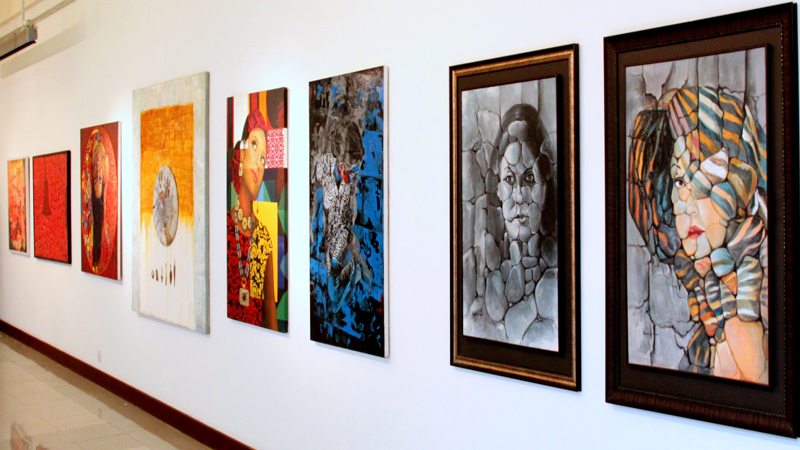 * Colin David
* Colin David
The country’s outstanding contemporary painter, Colin David, was an artist who understood the modern idiom in art, the sense of spatial harmony and brilliant use of colour. Born in Karachi in 1937, David graduated in Fine Arts from the Punjab University, Lahore in 1960. Later he completed his post graduate studies from Slade School of Fine Arts, London in 1962.
At Slade, he was mentored by Sir William Coldstream, an artist who painted in the celebrated method of the ‘Euston Road’ group. Colin admired Coldstream’s viewpoint involving the `reality rather than the impression’ of a subject. At the Slade School, Colin David for the first time had the opportunity to paint from life and found his artistic métier. David very successfully created sensitive studies of children at play, bringing to the canvas the absorbed concentration that children bring to play and learning.
David continued to exhibit his work regularly till his demise in 2008. He displayed his paintings mostly at his home and alternative venues to a selective audience. Some of his work is now on permanent display at the National Art Gallery, Islamabad.
The writer is an Islamabad-based policy advocacy, strategic communication and outreach expert. He can be reached at devcom.pakistan@gmail.com. He tweets @EmmayeSyed
Published in Daily Times, December 23rd 2017.